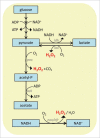Pathogen control at the intestinal mucosa - H2O2 to the rescue
- PMID: 28080210
- PMCID: PMC5341913
- DOI: 10.1080/19490976.2017.1279378
Pathogen control at the intestinal mucosa - H2O2 to the rescue
Abstract
Intestinal infections are a global challenge, connected to malnutrition and inadequate hygiene in developing countries, and to expanding antibiotic resistance in developed countries. In general, a healthy host is capable of fighting off gut pathogens or at least to recover from infections quickly. The underlying protective mechanism, termed colonization resistance, is provided by indigenous commensal communities (microbiota) that are shaped and aided by the host's epithelial and innate immune system. Commensal-pathogen interactions are governed by competition for a suitable niche for replication and stable colonization, nutrient availability, species-specific alterations of the metabolic environment, changes in oxygen tension and release of chemicals and proteinaceous toxins (bacteriocins). This protective intestinal milieu is further reinforced by antimicrobial factors and chemicals secreted by the epithelial barrier, by dendritic cell sensing and by homeostasis between T-cell subsets (Treg/Th17) in the lamina propria. The 3 players (host-microbiota-pathogen) communicate via direct interactions or secreted factors. Our recent manuscript illustrates that reactive oxygen species (ROS) are an integral part of colonization resistance and should be considered an interkingdom antivirulence strategy.
Keywords: C. rodentium; LEE pathogenicity island; NADH flavin Reductase; NADPH oxidase; antivirulence; defensive symbiosis; lactobacilli; reactive oxygen species (ROS).
Figures
Similar articles
-
Linking Pathogen Virulence, Host Immunity and The Microbiota at the Intestinal Barrier.Keio J Med. 2017;66(1):14. doi: 10.2302/kjm.66-001-ABST. Keio J Med. 2017. PMID: 28356548
-
Functions of innate immune cells and commensal bacteria in gut homeostasis.J Biochem. 2016 Feb;159(2):141-9. doi: 10.1093/jb/mvv119. Epub 2015 Nov 27. J Biochem. 2016. PMID: 26615026 Free PMC article. Review.
-
Defensive Mutualism Rescues NADPH Oxidase Inactivation in Gut Infection.Cell Host Microbe. 2016 May 11;19(5):651-63. doi: 10.1016/j.chom.2016.04.007. Cell Host Microbe. 2016. PMID: 27173933
-
Microbiota of the Small Intestine Is Selectively Engulfed by Phagocytes of the Lamina Propria and Peyer's Patches.PLoS One. 2016 Oct 4;11(10):e0163607. doi: 10.1371/journal.pone.0163607. eCollection 2016. PLoS One. 2016. PMID: 27701454 Free PMC article.
-
[The role of gut microbiota in the regulation of the immune response].Rev Med Chil. 2016 Jul;144(7):910-6. doi: 10.4067/S0034-98872016000700013. Rev Med Chil. 2016. PMID: 27661555 Review. Spanish.
Cited by
-
An in vitro medium for modeling gut dysbiosis associated with cystic fibrosis.J Bacteriol. 2024 Jan 25;206(1):e0028623. doi: 10.1128/jb.00286-23. Epub 2024 Jan 3. J Bacteriol. 2024. PMID: 38169295 Free PMC article.
-
One-carbon metabolism and related pathways in ruminal and small intestinal epithelium of lactating dairy cows.J Anim Sci. 2023 Jan 3;101:skad062. doi: 10.1093/jas/skad062. J Anim Sci. 2023. PMID: 36852676 Free PMC article.
-
Influence of Eimeria falciformis Infection on Gut Microbiota and Metabolic Pathways in Mice.Infect Immun. 2018 Apr 23;86(5):e00073-18. doi: 10.1128/IAI.00073-18. Print 2018 May. Infect Immun. 2018. PMID: 29440368 Free PMC article.
-
Distinct H2O2-Scavenging System in Yersinia pseudotuberculosis: KatG and AhpC Act Together to Scavenge Endogenous Hydrogen Peroxide.Front Microbiol. 2021 May 7;12:626874. doi: 10.3389/fmicb.2021.626874. eCollection 2021. Front Microbiol. 2021. PMID: 34025596 Free PMC article.
-
Potential of an Enzyme Mixture of Glucose Oxidase, Glucosyl Transferase, and Fructosyl Transferase as an Antidiabetic Medicine.Biomedicines. 2021 Jun 28;9(7):745. doi: 10.3390/biomedicines9070745. Biomedicines. 2021. PMID: 34203399 Free PMC article.
References
-
- Holland SM. Chronic granulomatous disease. Hematology/oncology clinics of North America 2013; 27:89-99, viii; PMID: 23351990; http://dx.doi.org/10.1016/j.hoc.2012.11.002 - DOI - PMC - PubMed
-
- Kim SH, Lee WJ. Role of DUOX in gut inflammation: lessons from Drosophila model of gut-microbiota interactions. Front Cell Infect Microbiol 2014; 3:116; PMID: 24455491; http://dx.doi.org/10.3389/fcimb.2013.00116 - DOI - PMC - PubMed
-
- Grasberger H, Gao J, Nagao-Kitamoto H, Kitamoto S, Zhang M, Kamada N, Eaton KA, El-Zaatari M, Shreiner AB, Merchant JL, et al.. Increased Expression of DUOX2 Is an Epithelial Response to Mucosal Dysbiosis Required for Immune Homeostasis in Mouse Intestine. Gastroenterology 2015; 149:1849-59; PMID: 26261005; http://dx.doi.org/10.1053/j.gastro.2015.07.062 - DOI - PMC - PubMed
-
- Leoni G, Alam A, Neumann PA, Lambeth JD, Cheng G, McCoy J, Hilgarth RS, Kundu K, Murthy N, Kusters D, et al.. Annexin A1, formyl peptide receptor, and NOX1 orchestrate epithelial repair. J Clin Invest 2013; 123:443-54; PMID: 23241962; http://dx.doi.org/10.1172/JCI65831 - DOI - PMC - PubMed
Publication types
MeSH terms
Substances
LinkOut - more resources
Full Text Sources
Other Literature Sources

